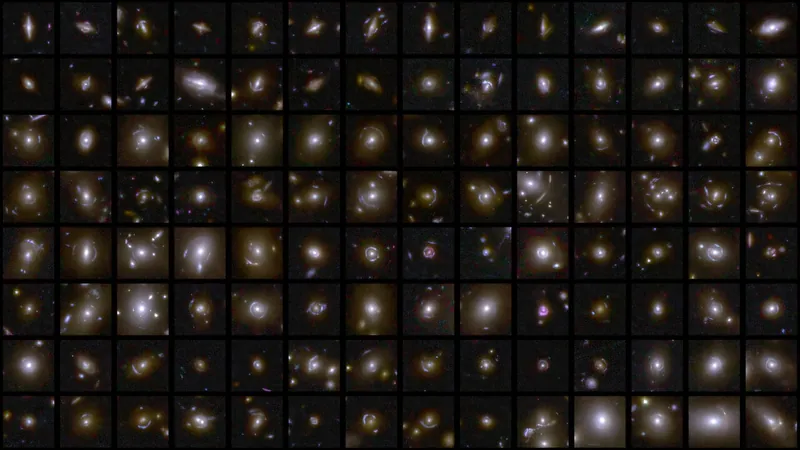
Euclid Mission Unveils Cosmic Secrets: A New Era of Astronomical Discovery Begins!
2025-03-22
Author: John Tan
On March 19, 2025, the European Space Agency (ESA) marked a significant milestone in cosmology with the release of the first batch of survey data from its ambitious Euclid mission. This groundbreaking initiative, aimed at unveiling the mysteries of the dark universe, offers a remarkable preview of deep fields populated by hundreds of thousands of galaxies in various shapes and sizes. This rich dataset not only highlights the large-scale organization of these galaxies within the cosmic web but also opens an extraordinary window into our universe's history.
The initial data release covers an expansive 63 square degrees of the sky—an area more than 300 times that of the full moon—through three detailed mosaics. Included in this treasure trove are numerous galaxy clusters, active galactic nuclei, and transient phenomena, alongside a groundbreaking classification survey of over 380,000 galaxies and 500 candidates for gravitational lenses. This classification was achieved through a collaborative effort that melded artificial intelligence with the enthusiasm of citizen scientists.
The potential impact of Euclid's findings is immense, as ESA's Director of Science, Prof. Carole Mundell, highlights: "With this release, we are unlocking a treasure trove of information for scientists to dive into and tackle some of the most pressing questions in modern science. We are committed to facilitating scientific progress for generations to come."
Tracing the Cosmic Web
In just the initial week of its survey, Euclid identified 26 million galaxies, some located an astonishing 10.5 billion light-years away. The mission will further observe these regions, significantly enhancing the richness of the dataset by 2030. By the time Euclid completes its six-year mission, it is expected to cover a total of one-third of the entire sky—14,000 square degrees—with high-quality detail that sets the stage for unprecedented discoveries.
Valeria Pettorino, ESA's project scientist for Euclid, expressed her excitement about the volume of data already available: "It’s impressive how one observation of the deep field areas has provided us with a wealth of information that can be utilized across various astronomical studies," she stated.
Collaboration of Humans and AI
Euclid’s mission aims to capture images of more than 1.5 billion galaxies over the span of its operation, generating around 100 GB of data daily. The partnership of AI with thousands of citizen volunteers has transformed the methods through which astronomers classify and analyze these vast amounts of data.
Mike Walmsley, a scientist from the University of Toronto, highlighted the revolutionary role of AI in this process: "AI is fundamental in fully exploiting Euclid's vast dataset, allowing us to deliver cutting-edge science in a matter of weeks compared to years-long analysis periods in the past." The first catalog produced features over 380,000 classified galaxies thanks to the efforts of close to 10,000 volunteers who trained AI algorithms like "Zoobot" to recognize unique features in galaxy imagery.
Gravitational Lensing: A Window to Dark Matter
Further extending its analytical capabilities, Euclid focuses on gravitational lensing, which occurs when light from distant galaxies is bent by the mass of foreground objects. This phenomenon serves as a powerful tool for mapping dark matter's distribution across the universe.
The initial release includes a catalog of 500 candidates for strong lensing effects, with the expectation of cataloging up to 100,000 strong lensing candidates by the end of the mission. This could offer insights into how ordinary and dark matter interact on cosmic scales.
The Path Ahead: What’s Next for Euclid?
As the mission progresses, Euclid is set to measure the distorted shapes of billions of galaxies over a history spanning 10 billion years. This will contribute to a three-dimensional understanding of how dark matter shapes the universe. Pierre Ferruit, ESA's mission manager, stated, "This data release showcases the incredible potential of combining Euclid’s power with AI, citizen science, and expert analysis to tackle the vast volume of data that we anticipate."
With its cutting-edge technology and immense data output, the Euclid mission stands as a beacon of hope, promising to illuminate the shadows of our understanding and catalyzing new discoveries that could redefine our grasp of the cosmos. Brace yourself, as we are on the brink of a scientific revolution!


 Brasil (PT)
Brasil (PT)
 Canada (EN)
Canada (EN)
 Chile (ES)
Chile (ES)
 Česko (CS)
Česko (CS)
 대한민국 (KO)
대한민국 (KO)
 España (ES)
España (ES)
 France (FR)
France (FR)
 Hong Kong (EN)
Hong Kong (EN)
 Italia (IT)
Italia (IT)
 日本 (JA)
日本 (JA)
 Magyarország (HU)
Magyarország (HU)
 Norge (NO)
Norge (NO)
 Polska (PL)
Polska (PL)
 Schweiz (DE)
Schweiz (DE)
 Singapore (EN)
Singapore (EN)
 Sverige (SV)
Sverige (SV)
 Suomi (FI)
Suomi (FI)
 Türkiye (TR)
Türkiye (TR)
 الإمارات العربية المتحدة (AR)
الإمارات العربية المتحدة (AR)